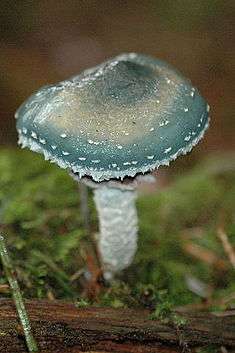Stropharia aeruginosa
| Stropharia aeruginosa | |
|---|---|
 | |
| Stropharia aeruginosa | |
| Scientific classification | |
| Kingdom: | Fungi |
| Division: | Basidiomycota |
| Class: | Agaricomycetes |
| Order: | Agaricales |
| Family: | Strophariaceae |
| Genus: | Stropharia |
| Species: | S. aeruginosa |
| Binomial name | |
| Stropharia aeruginosa (Curtis) Quel. | |
| Stropharia aeruginosa | |
|---|---|
|
| |
| gills on hymenium | |
| cap is convex | |
| hymenium is adnate | |
| stipe is bare | |
| spore print is brown | |
| edibility: unknown | |
Stropharia aeruginosa, commonly known as the verdigris agaric, is a medium-sized green, slimy woodland mushroom, found on lawns, mulch and woodland from spring to autumn. The edibility of this mushroom is controversial - some sources claim that it is edible, while others claim it to be poisonous, although effects are little known and its toxic constituents undescribed.
Taxonomy
The French mycologist Lucien Quélet gave it its current binomial name in 1872, after it was initially described as Agaricus aeruginosus by William Curtis in 1784. The Dutch mycologist Machiel Noordeloos placed it in the genus Psilocybe in 1995. The specific epithet aerūgǐnōsa is Latin for "covered in verdigris (copper-rust)".[1]
Description
The cap is convex, broadening, and becoming umbonate with age. It is from 2–8 cm in diameter. At first it is a vivid blue/green, and very glutinous (slimy), with a sprinkling of white veil remnants around the edge. The colour in the gluten fades, or is washed off as it matures, and it becomes yellow ocher, sometimes in patches, but mostly at the centre. Finally, it will lose the blue-green coloration completely. The stem is quite long and of uniform thickness. It has a fragile brown/black ring, and below this the stem is covered in fine white scales, or flakes. The gills are initially white, then clay-brown, and sometimes have a white edge. The spore print is brownish-purple, and the oval spores 7–10 x 5 μm.[2]
Similar species
- Stropharia caerulea Kreisel – a dowdier cousin.
- Stropharia pseudocyanea (Desm.) Morgan – a smaller; slighter, but strikingly similar grassland species, with a very fleeting ring.
Distribution and habitat
This mushroom is common in grassy woods, and on roadside verges in Britain, Europe, Asia (Iran)[3] and parts of North America, growing on rotting wood. It particularly favours wood-chip mulches in gardens, and parks.
Edibility and toxicity
The verdigris agaric is reported as poisonous in many guidebooks printed in the Western Hemisphere,[4] yet the effect of poisoning is little known and toxic constituents unknown.[5]
According to some European guidebooks the verdigris agaric is actually edible, but undesirable due to mildly spicy taste.[6]
See also
![]() Media related to Stropharia aeruginosa at Wikimedia Commons
Media related to Stropharia aeruginosa at Wikimedia Commons
References
- ↑ Haas, Hans (1969). The Young Specialist looks at Fungi. Burke. p. 215. ISBN 0-222-79409-7.
L. aeruginosus 'covered in copper-rust'
- ↑ Roger Phillips (2006). Mushrooms. Pan MacMillan. p. 248. ISBN 0-330-44237-6.
- ↑ Asef Shayan, M.R. (2010). قارچهای سمی ایران (Qarch-ha-ye Sammi-ye Iran) [Poisonous mushrooms of Iran] (in Persian). Iran shenasi. p. 214. ISBN 978-964-2725-29-8.
- ↑ Arora, David (1986). Mushrooms demystified: a comprehensive guide to the fleshy fungi (2nd ed.). Berkeley: Ten Speed Press. p. 380. ISBN 0-89815-169-4.
- ↑ North, Pamela (1967). Poisonous Plants and Fungi in colour. Blandford Press & Pharmacological Society of Great Britain. pp. 111–12.
- ↑ STROPHARIA AERUGINOSA, СТРОФАРИЯ СИНЕ-ЗЕЛЕНАЯ